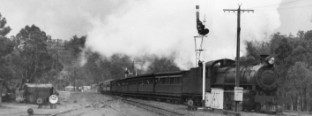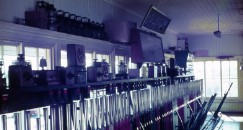Subiaco (2)
SUBIACO (2) | |
WAGR - Eastern Railway (E. R.) | |
1938 WAGR MAP Mileage = 2 | |
Next Down Station: | Next Up Station: |
Quick Facts |
|
Opened |
Closed |
29/07/1923 |
1990 |
Mechanical |
Electrical |
45 Levers |
Illuminated Diagram |
The Subiaco Signal Cabin was, until recently, one of only two signal cabins left in place after the the electrification of the Perth metropolitan area suburban network was finalised in 1990. At the end of its working days it 'worked' with the "always attended" Perth Box 'B' and Claremont (although like Subiaco itself, this cabin was much 'switched out'). In this case, the next 'Up' cabin Subiaco would work with was Cottesloe or very rarely North Fremantle.
Physically, the cabin was located between Daglish (once a Block Box) and West Leederville. Just east of West Leederville was another Block Box called Cecil Street which is in a deep cutting formerly known as Mount Eliza (which also had a signal cabin of the same name). These were used during the Sykes Lock and Block era to shorten the 'headway' between trains and therefore speed up the flow of traffic. Both Daglish and Cecil Street are now but memories. The location of the Daglish Block Box (which replaced the nearby Lawler Street Block Box) can still be located by the 'rodding tunnel' under the platform at Daglish station and the wide, bricked-up windows of the signal cabin above same. Little remains of the Cecil Street Block Box, though for those with quick eyes on passing 'Up' suburban trains, will see the stonework of the foundations where the box was once located in the deep cutting between West Perth (now City West) and West Leederville stations.
The Subiaco signal cabin serviced a number of sidings for factories as well as the normal railway Goods Shed and yards. It replaced an earlier platform-level signal cabin which was located on the Fremantle end of the 'Up' platform. Whilst this earlier cabin was long gone when the present Subiaco cabin closed, evidence of the former cabin's location could still be found in the form of the 'rodding tunnel' under the platform - that was until the entire station was redeveloped into an underground station!
Thankfully, the Subiaco Signal Cabin has survived this redevelopment. It has been moved to the operating 2' 0" gauge Bennett Brook Railway at Whiteman Park. Here at least, it will continue to be used in the role for which it was created, and will control actual train movements through the railway's most complex station. Soon, the Subiaco cabin will be back in operation - beginning another whole new life - a real Phoenix!
The Subiaco cabin has had quite a life! It was opened in July 1923 (after an as yet unconfirmed relocation from the Geraldton / Narngulu area). Later that year, in line with other cabins along the suburban section of the Eastern Railway, Duplicate Levers were positioned on the platform. This allowed for stopping trains to be protected by station staff being able to place the Home signals to stop when the Signal Cabin was unattended and 'switched out'. The Duplicate Levers were removed in February 1947. In April 1956 disaster struck when the cabin was destroyed by fire. According to the records, the cabin was back in action by the 7th of May in the same year, and this must have been an incredible feat of re-construction because virtually all that remained of the cabin was part of the front wall, the interlocking room floor and the lever frame. The robustness of the McKenzie and Holland lever frame was proven to this author when it was discovered on a recent visit to the cabin at the Bennett Brook Railway, that the frame still shows the burnt residue of oil and paint on the interlocking machine. It would seem that the frame had survived the fire, was re-oiled (and no doubt fully tested) and put straight back into service without a thorough cleaning! Evidence of the fire can still be seen in other areas as well. The main timber support beams for the lever frame, and end wall uprights are still heavily charred, but obviously still useable!
The interior of the Subiaco cabin was pretty much standard for W.A.G.R. cabins, although the ceiling and walls were of plasterboard. The 45 levers of the McKenzie and Holland No. 9 Patt. frame seem little effected by their history! A standard glass-fronted 'black' diagram and normal accoutrements such as S.G.E. shelf lights and glass-domed Union Switch & Signal Company time releases can be seen. It was sad to report that the block bells and bell plungers seen on this shelf, along with the wooden-cased telephones on the walls of the cabin were unfortunately removed by 'persons unknown' during the cabin's relocation in December 1998. It would be welcome gesture if they were returned - even anonymously, to the B. B. R.
The only colour photo of the 'black' diagram to hand at present, is not quite in focus. Yet it does show the layout of the tracks through the station. West Leederville station is to the left and the Daglish station is on the right. The Brown track just discernable below the 'Back Platform' had points to the various industries served by the cabin. This author was quite surprised on his first (and only) visit inside the cabin to see just how far the sidings extended into the nearby surrounds. "Royal Show" special passenger trains were also run between Fremantle and Subiaco during Show Week, although it was never as busy as Claremont. Subiaco did cater for the AFL football fans though, and many have journeyed to the "Subiaco Oval" to watch their teams 'battle' the opposition. Naturally enough, the new 'underground' station fulfills this role without Signal Cabin, Signalman or extra platforms.
Information researched and interpreted by Chris. J. E. French of SignallingWA
Any additional information on this signal cabin would be most welcome - please use the e-mail form provided on this page.
Photographs © by David Beazley, Chris. J. E. French and Ross Newton
Buy this page or View your SignallingWA Shopping Cart
This page is copyright, and permission must be sought from SignallingWA before this page is used for any purpose other than personal education.
SUBIACO (2) Employees | ||
This list may not be complete and does not yet include employees who worked here without being appointed. Where an appointment date is unknown, the Weekly Notice (WN) date advising of the appointment or other official documentation, i.e. Certificate of Competency (CC) will be used. | ||
Name | Appointed | Position |
| Rance, Fred | 14/06/1985 - CC | Signalman, Class 2 |
| Bailey, Phillip W. | 01/05/1987 - CC | Signalman, Class 2 |
Is a name missing? Please submit any corrections / additions with suitable evidence using the e-mail form above. | ||
12/02/2013 - Former W. A. G. R. Employee Fred Rance remembers:
"In the mid 1980s I was stationed in Perth and was working Perth 'C' Cabin and Perth Box 'B' when I was asked to accompany a Safe Working Inspector and go with him to Subiaco. So, off we went, and when I asked him what was going on, he replied "I am going to give you a crash course on working this cabin". We opened the cabin and had to open the windows as it was a bit smelly in there because it was locked-up all the time.
We had an ANNETTS KEY which unlocked the frame. Once inserted into the lock on the GREEN lever, we then rung bell code to the stations in eirther direction to let them know that Subiaco was 'cut-in' - from memory I think it was 5-5-5 to cut in and 7-5-5 to 'cut-out'.
I was shown all the moves of the cabin and, in between trains, had a go at setting points and signals for the yard. After a while and after cutting the cabin out again, we went out in 'the field' and looked at the interlocking then off back to Perth. I was examined by another Inspector the next day and passed. Over the next couple of years I worked the cabin mainly during 'footy' season.
One day during the Footy semi-final, a big crowd of people were gathered on the UP platform waiting for the train. I went out on the balcony to see if everything in the crowd was okay, and I noticed a young bloke, a bit on the cubby side, standing near the edge of the platform holding a transistor radio and a book. The train approached an ADL railcar set, and as it was pulling onto the platform this bloke jumped off into the front of the train and I saw him disappear under the railcar! I quickly rang Train Control and the Platform Inspector at Perth and told them of the possible fatality that had just occured. They called the emergency services and the officer on duty with me took over the situation by controlling the crowd.
The emergency services arrived they found the young bloke under the train. He was still alive, but pinned under the final drive motor of the railcar. He couldn't talk because of the way he was stuck there. The fire bridgade guys used hydaulic jacks to lift the railcar and the Officer could communicate with the young bloke by holding his hand and getting him to squeeze twice for 'yes' and once for 'no', they eventully got him out and rushed him off to hospital. The fireys tried to let the jacks down but they failed, so the relief driver was asked to reverse the railcar and drive it off the jacks - luckly it worked. The train was okay to leave so we sent it to Fremantle empty, passengers were sent by buses. The Platform Inspector (PI) rang and asked what was going on and where was the train. I told him that it had gone to Fremantle. He said to tell them to work it back to Perth 'all stops'. I said, "NO. It's been off the rails and can't carry passengers until its been checked". He slammed the phone down, and I signalled the trains through the station after the emergency vehicles had cleared the track. With every thing back to normal I cut the cabin out and went home still shaking after what I saw. I was the last Signalman to work the cabin at Subiaco, and later on I managed to obtain the Train Register book before the cabin was removed."


